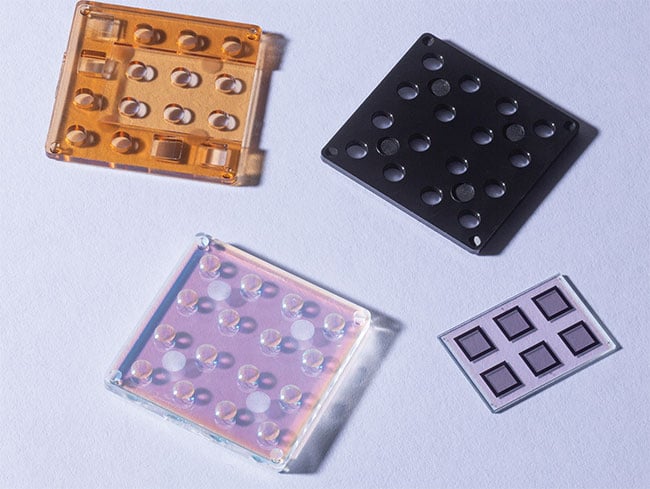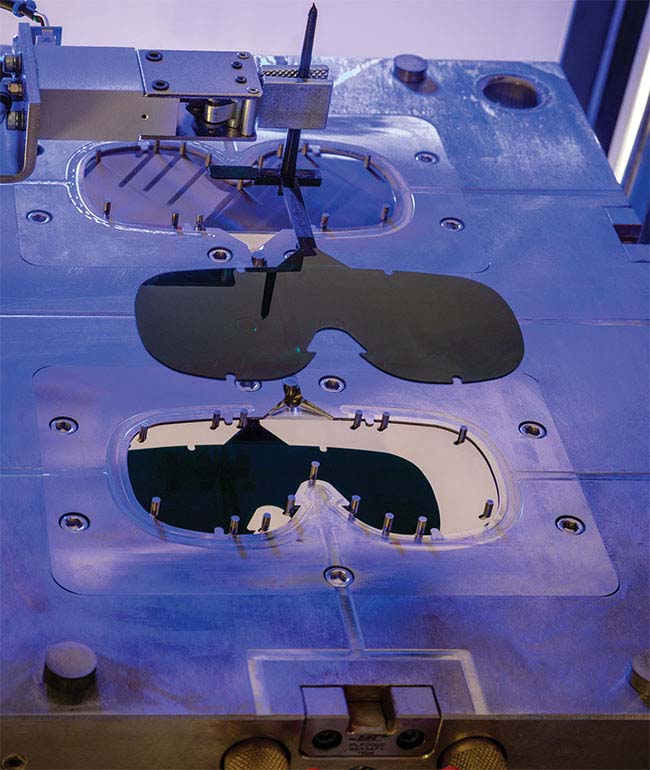The promise of polymer optics lies in reimagining what is possible: Designs that cannot easily be realized in glass are not only achievable using polymer optics but also make lighter and cheaper optical systems.
MARIE FREEBODY, CONTRIBUTING EDITOR
Polymer optics, also known as plastic optics, are ideal for reducing the footprint and weight of optical systems and assemblies, further fueling the demand for polymer optics in end uses in which these characteristics are important, such as in autonomous imaging, wearables, head-mounted displays, multicamera
arrays, and point-of-care medical devices, among many other applications.

Polymer optics at the Jenoptik production facility in Triptis, Thuringia, in Germany. Courtesy of Jenoptik.
The breadth and complexity of available, off-the-shelf precision polymer optics has grown in the last few years, helping engineers to more rapidly design and prototype optics using the materials.
Given the design flexibility offered by plastics, manufacturers stress the advantage of seeking consulting early in the design process to determine the best
material, the number of elements, and how manufacturing will affect the design.
Primarily chosen for high-volume applications, polymer optics help to drive down cost due to their ability to be efficiently mass-produced via injection molding, a high-throughput method of reproducing complex surface geometries. In some cases, molded optics such as aspheres can forego the added cost of a polishing step.
Polymers enable unique optical surfaces or features that cannot be achieved by using traditional glass manufacturing. And, in some cases, polymers can reduce the number of components in a system by combining mounting, alignment, or other mechanical features with the lens itself.
The potential for integrating mounting and alignment features makes polymers an attractive candidate material for micro-optics, which can be difficult to handle. Polymers put fewer constraints on the size of a lens compared to glass, especially when manufacturing small optics. Polymer lenses, for example, can be molded with outside diameters of less than 1 mm, whereas traditional fabrication processes for glass optics typically yield outside diameters greater than 3 mm, barring the use of specialized equipment for edging or other fabrication technologies, such as lithography and etching.

A laser scanning lens array used in a dermatological laser device. The array features 12 nonrotationally symmetric (freeform) aspheric lenses and integrated mounting features, and it is injection-molded from polycarbonate. Courtesy of Fresnel Technologies Inc.
“An optical polymer component’s geometry has few limitations and offers design freedoms that are not economical or achievable with traditional glass optics manufacturing,” said Lynn Dobosz, key account manager at Jenoptik. “For example, Fresnel lens arrays with small structures and high aspect ratios, strong aspheres, diffractive, cylindrical, freeform, and prismatic structures can be made.”
Lightweight design
Reducing weight and/or cost are important design considerations for many imaging applications. Plastic optics are often suitable options. The list of end markets for these applications is long and growing, encompassing medical and biomedical, security and defense, machine vision, analytical instrumentation, robotic devices, automotive, and consumer electronics.
For GS Plastic Optics, the past three to five years have seen a marked increase in the demand for polymer optics in disposable medical devices, as well as for the lidar and imaging systems that help autonomous vehicles to navigate, whether on the road or within warehousing and industrial settings.
Consumer electronics is also driving interest in polymer optics due to the large and growing number of optical components in smart devices. Minimizing the weight of these components is a huge factor in design decisions.
Replacing glass with polymer optics can help to reduce the weight of augmented and virtual reality (AR/VR) headgear, for example, but the ability to shape and integrate polymer components offers further lightweighting opportunities to enhance user experience. These advantages also apply to smartphone cameras, which have incorporated an increasing number of optical components over the past decade.
Design for manufacturability
Single-point diamond turning, computerized numerical control machining, and injection molding all help to fashion polymers into common optical forms, as well as into aspheric lenses, optical prisms, cylinder lenses, toroid lenses, and freeform optics.
Injection molding, during which melted thermoplastic is forced into single- or multicavity molds, is the most common and cost-effective way to manufacture polymer optics in high volumes and with specialized surface features. “Injection molding is a highly efficient method of reproducing complex surface geometries,” said Val Moshkovskiy, senior applications engineer for GS Plastic Optics. “The process allows the manufacturing of optical surfaces and axes that directly correlate to mechanical mounting fiducials.”

Optical and mechanical elements of the optics for a 16-camera computational imaging system, all molded in plastics materials.
Courtesy of Fresnel Technologies Inc.
Molding polymer optics requires precise modeling and simulation to ensure the selection of a proper mold design. Polymer lens design needs to take manufacturing steps into account, as well as the performance of the lens itself. Considerations include how the material will fill the mold cavity, how easily it will be ejected, and how the thermoplastic will flow across the internal surfaces of the tool to minimize adverse effects during the injection process, Jenoptik’s Dobosz said. “This is where thickness uniformity of features becomes important.”
Designing for manufacturability applies to polymer optics as much as to conventional glass components, though polymers require a shift in mindset
because they present different manufacturing methods, design considerations, and tolerances.
“Optical drawing templates call for requirements that are not applicable to plastics,” said Nelson Claytor, president of Fresnel Technologies Inc. “And optical design software does not take into account the differences in fabrication and measurement between polymer and glass optics.”
He provided the following example: “Designers should consider questions, such as whether the optical system will combine polymer elements with other materials that have drastically different coefficients of thermal expansion, since solving the potential thermal issues will require thought from the beginning.”
The heat is on for polymers
A polymer’s index of refraction is inversely proportional to the temperature of the material. As its temperature increases, its refractive index decreases. The impact on performance is significant and about 20× that of glass. Thus, it is important for designers to consider thermal effects over a wide temperature range.
Temperature is not just a consideration for the final application. It also affects
the manufacture and coating of polymer
optics. The underlying issue is that polymers have a significantly lower glass transition temperature than glass does, which means vacuum coating chambers must operate at lower temperatures.
“In general, the result is lower adhesion of the coating to the polymer substrate as compared with coatings on glass,” said Dale Buralli, chief scientist at Apollo Optical Systems Inc. “Techniques such as plasma pretreatment of the substrate and the use of Adhesor layers are often implemented.”
GS Plastic Optics’ Moshkovskiy said applying certain types of thin films — such as high-reflectivity coatings, bandpass filter coatings, and long- or shortpass filter coatings — is particularly tricky with polymer lenses.

An injection molding tool holds a Fresnel prism formed from tinted acrylic in the shape of goggles. Courtesy of Fresnel Technologies Inc.
“The number of coating layers that can be applied to a plastic substrate without a risk of delamination is limited by a relatively low coating temperature and a need to match coefficient of thermal expansion of the coating materials with that of a substrate,” he said. “In addition, polymer surfaces scratch more easily than glass. So coatings for polymer optics often must further include a protective hard coat.”
The most widely used optical polymers for applications in the visible range are polymethyl methacrylate (PMMA), also known as acrylic; polycarbonate (PC); polystyrene (PS); cyclic olefin polymer (COP); and cyclic olefin copolymer (COC).
Acrylic is probably the most popular polymer material, offering a favorable combination of clarity, UV stability, and a relatively low cost. It is commonly used for fabricating Fresnel lenses and off-the-shelf aspheric lenses.
Polycarbonate and cyclic olefins generally offer higher heat resistance than acrylic, and so they find use in higher-temperature applications, including some laser and solid-state illumination systems in which acrylic is not suitable. Dermatological laser devices also use polycarbonate laser scanning lens arrays.
Polycarbonate further exhibits a very high impact resistance, making it suitable for applications such as protective viewing windows.
Recent developments in optical polymer chemistry have produced new materials with comparatively high refractive indices, such as OKP polyester resins (1.6) and Iupizeta high-performance polycarbonate (1.68). The latter is an optical resin polymer developed by Mitsubishi Gas Chemical and is used in optical assemblies in smartphones and other precision applications.
“These higher-index polymers are valuable in applications such as cellphone camera lenses, where the available space is at a premium and the higher indices help reduce lens sag and size,” Buralli said. “It is also becoming more common, particularly for some AR/VR systems, to utilize polarization as a fundamental operation characteristic.”
For these systems, control of stress birefringence in the material is an important production goal, and proper material choice is critical. Polycarbonate, for example, has high intrinsic birefringence.
Future polymer optics
The optical performance parameters of glass and metal can be tightly controlled by machining each component individually. While polymer optics are also sometimes machined, the use of injection molding in their fabrication enables
many mechanical and optical properties
to be built into the tooling, allowing complex optics to be replicated at higher production.
“It has long been the strength of polymer components that optical and mechanical features can be combined on a single component and produced at the same time. This trend will only continue as optical surface geometries become more complex,” Buralli said.
End applications — from smartphones to drones, to enhanced reality headgear — are driving further demand for more compact and lightweight optical systems with consolidated or reduced component counts.
Optics suppliers and manufacturers also expect to see continued growth in freeform optics that combine multiple optical surfaces on a single molded element.
These converging trends all suggest that a strong future is shaping up for moldable polymer optics, which can enable all of these features more easily than glass.